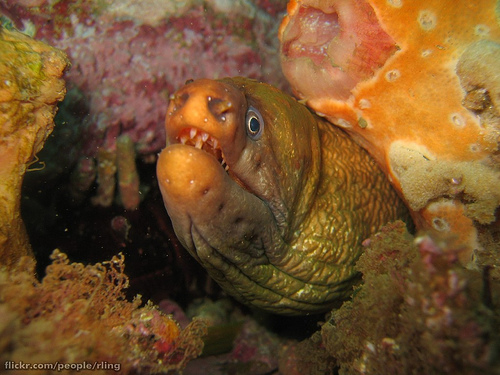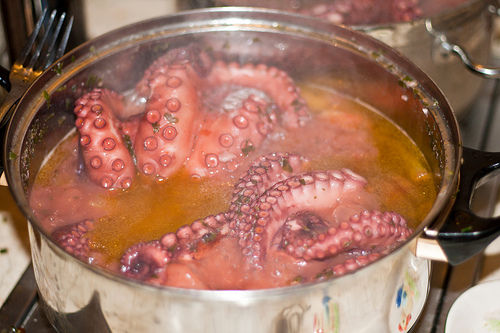Interacting with Other Organisms
Upon
hatching, the octopuses
experience a very vulnerable planktonic stage. They are snacks
for very many creatures, including crabs. A crab can be seen
snatching hatchlings out of the water in the video on the
reproduction page at around 4:56. (The crab is in the lower right corner
of the screen.) Many Pacific octopuses do not even reach
maturity, which occurs at about 2-3 years of age.

In adulthood, the octopus lives a solitary lifestyle.
They will rarely see another octopus and will, occasionally,
even eat a fellow Pacific octopus. The only time two octopuses
are ever seen together is during the
mating process.
The Pacific octopus is food for many other marine
creatures. Moray eels are great predators of octopuses. They are
able to sneak into dark dens where the octopuses live and
attack. Sharks are also major predators of the Pacific octopus.
(Although, that's not how it played out in this
video.) Killer whales, or orcas, have also been observed
eating the giant Pacific octopus. It is believed however that
they only consume senescent males because the whale is far too
big to get down into an octopus's den. Seals and other marine
mammals also enjoy an octopus meal.
Bacteria often affect an octopus going through
senescence. During senescence the
octopus will develop lesions, which frequently get bacterial
infections. The octopus is unable to fight off the bacteria, so
the bacteria win and the octopus dies. Although a virus is not a
living creature, it has also been found to greatly affect the
octopus. Autophagy is a neurological disorder in which the virus
attacks the octopus's central nervous system. This disruption
causes the octopus to eat its own arms. It was once believed the
octopus did this due to stress.

Humans are some of the greatest predators of the Pacific
octopus. They are fished to be used as fishing bait for other
creatures and to be sold as seafood. Octopus can be used as an
ingredient in almost any seafood dish, including sushi and
pastas. It has a bit of a tough or rubbery texture so sometimes
the "baby" octopuses are used when available. This
video show's how to properly clean and cook an octopus
into
a spaghetti dish. In the cooked form, octopus contains
about 140 calories per ounce.
Studies have also shown that Photobacterium phosphoreum,
cyanobacteria, and Streptococcus
mutans are active metabolizing bacteria that can be found
in octopuses. This affects humans due to the fact that these
bacteria affect the octopus's shelf life in grocery stores.
Back to Reproduction Forward to Intelligence